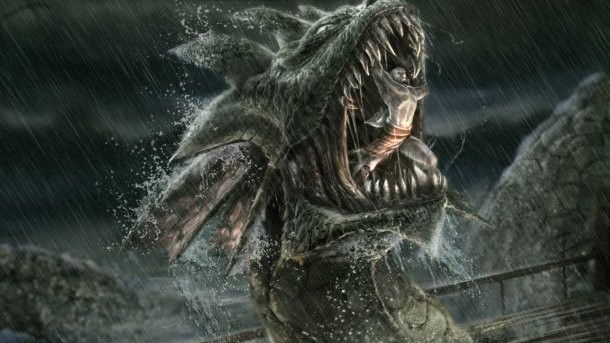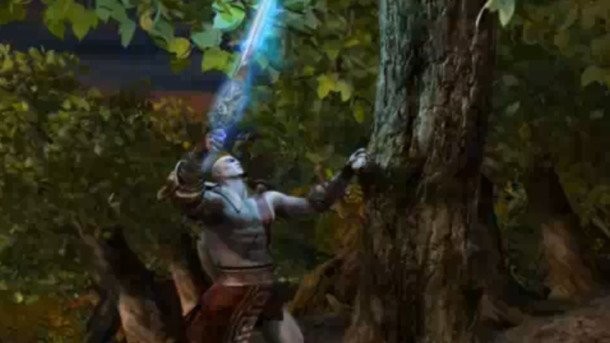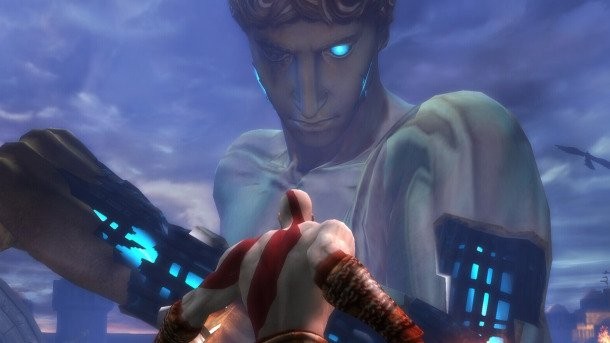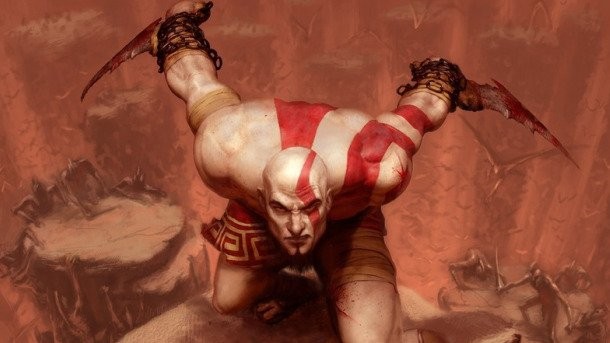Our extra-large special edition is here. Subscribe today and receive the 25% longer issue at no extra cost!
Top 10 God Of War Moments

Gamers got their hands on God of War III this week, and many have already seen how the third entry ties together the loose ends of the series. That’s no small task, considering Kratos’ entire bloody quest for revenge spans three consoles games and one handheld outing. To honor the conclusion of the Ghost of Sparta’s saga, we’ve compiled our favorite moments from all four God of War games. Be warned: there are major spoilers ahead.
10. Hydra (God of War)
After being constantly harried by the Hydra’s serpentine heads, Kratos faces the monster one-on-one atop the mast of a ship. This is the first boss fight players experience as Kratos, and the enormous size of the mythical beast makes the odds appear unfair. However, we learn that size doesn’t matter to Kratos – the battle against the Hydra cements Kratos’ defining philosophy in the minds of players: If it can bleed, it can die…even if it almost swallows you whole.
9. Gaia Revealed (God of War II)

Betrayed by Zeus and impaled by the Blade of Olympus, Kratos nearly dies at the beginning of God of War II. At this point, the female narrator says: “His death was something that I could not allow.” This moment contains the shocking revelation that the voice explaining the events of both God of War and God of War II isn’t just a detached, omniscient narrator – it’s been the titan Gaia all along, and she has a plan.
8. The Doppelgangers (God of War)
The phrase “you are your own worst enemy” holds true in this encounter, where Kratos needs to fight back a veritable army of doppelgangers in an illusion created by Ares. The Kratos clones seem to advance endlessly on the specters of Kratos’ dead family, but they also take plenty of swipes at the real Ghost of Sparta as the world crumbles around them. In addition to being an intense story moment, stemming the tide of clones is also one of the most challenging parts of the game.
7. Perspective Puzzle (God of War III)
Hera’s garden provides an intriguing twist on the block-pushing and lever-pulling puzzles of the series’ past. Inspired by the art of M.C. Escher (pictured above), this area forces Kratos to change his point of view in order to make the pieces align. This puzzle also gets major points for the way it makes you haul around a god’s corpse to weigh down a pressure-sensitive switch.
6. Cliffhanger Ending (God of War II)
The Sisters of Fate are dead, Athena has given her life defending Zeus, and the king of the gods is wounded. That’s when things get really bad: While riding atop Gaia as she and her titan brethren scale Mount Olympus, Kratos bellows, “Zeus! Your son has returned! I bring the destruction of Olympus!" Just as the action reaches this crescendo, the screen goes black and gamers are teased with the phrase “The end begins.” Now that’s how you get people pumped up for a sequel! 
5. The Killing Blow (God of War III)
Among those who have already beaten God of War III, there is one question that is more commonly asked than any other: How long did you keep pressing the button?
4. The Elysium Fields (Chains of Olympus)
Finally obtaining a speck of happiness in his grim life, Kratos is reunited with his daughter Calliope in the Elysium Fields. Unfortunately, if he stays with her, it means the end of all life, god and mortal alike. This triggers a sequence where players must forcefully push Calliope away and ignore her protests, abandoning her and any hope of redemption for eternity.
3. The Colossus of Rhodes (God of War II)
If there’s a better opening to video game than God of War II, we haven’t seen it. The massive Colossus of Rhodes hunts Kratos through the city, smashing buildings and crushing soldiers in its relentless assault. After Kratos is robbed of the full scope of his power, the only way he can take down the rampaging statue is from the inside. Weakening the Colossus enough to create an opening results in some of the most memorable and jaw-dropping sequences in the history of the PlayStation 2.
2. Cronos (God of War III)
Normal video game levels are static locations, like caves, castles, and towns. In God of War III, Cronos proves that a level can be a living (and angry) titan. In this fight, the cinematic camerawork takes center stage, perfectly conveying the sheer size of Cronos by making Kratos nothing more than tiny dot on Cronos' skin. The thrill of scaling the mammoth beast and evading his attacks is only topped by the satisfaction of chopping away at him piece by piece.
1. The Ashes (God of War)
The gameplay in the God of War series is all about epic encounters and stylish combat, but it’s a story moment that defines Kratos and sets the tone for future installments. It doesn’t take long to discover that Kratos is a brutal and capable fighter obsessed with revenge, but you don’t discover why until late in the original God of War. When you see events that haunt Kratos – how he murdered his own wife and child and is doomed to wear their ashes – the rage of the character solidifies. and you want to see the gods pay just as badly as Kratos does.
Honorable Mentions:
The Death of Poseidon (God of War III): Three words: First-person kill
Opening Pandora’s Box (God of War): Growing really big may not be the coolest god-killing power ever, but being able to square off against Ares with a tiny city in the background is still sweet.
The Sisters of Fate (God of War II): In addition to just being good boss fights, Clotho, Atropos, and Lahkesis are each terrifying in their own right.
For even more God of War stories, click the image below to check out the God of War III launch hub!

Get the Game Informer Print Edition!
Explore your favorite games in premium print format, delivered to your door.
- 10 issues per year
- Only $4.80 per issue
- Full digital magazine archive access
- Since 1991










